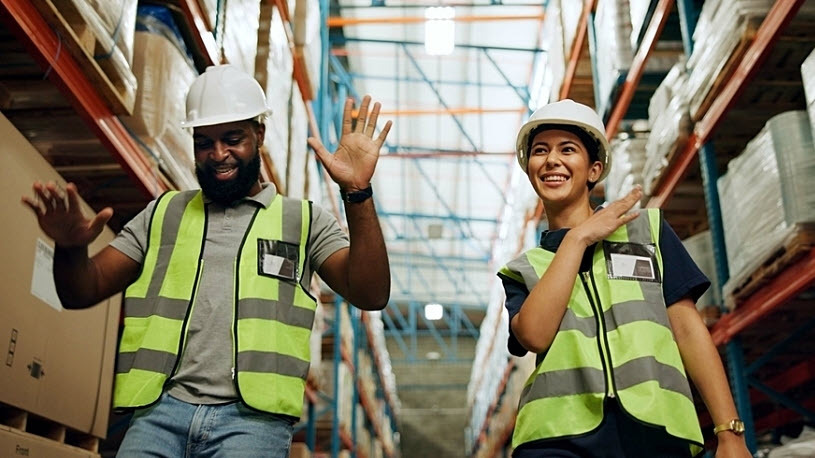5 HR Trends to Follow in 2025
Part of a series | 2025 HR Trends Series

The top HR trends for 2025 range from talent shifts to compliance challenges to technological advancements. Here's a preview of five of the ten trends signaling what the coming year has in store for leaders across industries and around the globe.
The workplace is fast-moving and ever-changing. But amid that constant change is some consistency: HR and business leaders who keep on top of emerging trends could enjoy a competitive advantage. The major shifts forecasted for 2025 can be linked back to broader talent, compliance and technology trends already impacting businesses worldwide. Keeping a close eye on HR trends is crucial for leaders to make informed decisions about the future.
5 HR trends to follow in 2025
1. Generative AI continues to revolutionize HR, jobs and the workplace
Generative artificial intelligence (AI) has already found its way into many aspects of HR, how work gets done and the employee experience. From payroll and benefits to compliance and people analytics, generative AI offers options for streamlining processes, boosting productivity and scaling teams. Because generative AI has evolved so quickly, many companies are still in the early stages of exploring its benefits, while others have already integrated the technology.
Businesses of all sizes could benefit from generative AI, says Naomi Lariviere, chief product owner, vice president of product management, shared services, ADP.
"Businesses with 1 to 49 employees may not yet fully realize the potential productivity boosts generative AI can offer," Lariviere says. "There's significant untapped value in exploring what this technology can bring to the table for small enterprises. Businesses with 50 to 999 employees generally say they need to understand the technology better. They don't always know what it is but believe it could help them and are interested in learning more. When I talk to businesses with 1,000 or more employees, I usually speak to their C-suite information officers and data scientists. These companies have the experts, tools and person power to utilize generative AI."
2. Skills have emerged as a strong indicator of employee success
In response to talent scarcity trends over the past few years, many employers have adopted a skills-based approach to talent. This approach includes evaluating candidates on skills and potential (rather than solely in-position experience or formal education), implementing upskilling programs to train employees on skills crucial to business success and investing in internships and other programs that help build a stronger talent pipeline. Research shows that 90 percent of organizations using a skills-based hiring method report reducing their mis-hires, and 94 percent agree that skills-based hiring is more predictive of on-the-job success than resumes.
Tiffany Davis, chief inclusion and diversity officer, ADP, encourages employers to help their employees lean into the skills and experiences they have.
"Whether these have come through other work experiences, military experiences, volunteer experiences or something else, those experiences matter," Davis says. "Employers may also want to evaluate the language of their job postings if they want to lean into a skills-based approach to hiring. Are they using the descriptor 'degree preferred,' and, if so, why? Is a degree truly needed for the role? If not, why is it 'preferred?'"
3. Talent is becoming more geographically dispersed
Technological innovations have made it easier for businesses to have a larger geographical presence with digitally connected workforces. The rise of remote work also offers organizations unprecedented access to new talent pools, as employers can now hire candidates outside their local areas, found that, from February 2020 to June 2023, the share of cross-metropolitan workers, also known as long-distance or remote workers, rose from 23% to more than 31%. Remote work can offer many other benefits, including worker-job matching, work-life balance, reduced turnover and lower labor costs.
4. Pay equity and pay transparency remain business priorities as gaps persist
Pay equity and pay transparency continue to be hot topics globally as pay gaps persist. In 2023 and 2024, more than 12 states and D.C. passed pay transparency laws. Eight others and Puerto Rico have legislation going into effect or are considering pay transparency requirements. Some local governments are also mandating pay transparency, with cities and counties requiring employers to disclose pay ranges to candidates.
Meryl Gutterman, senior counsel, ADP, suggests working toward a full understanding of your company's pay data so that you can foster a positive relationship with employees.
"Understanding your pay data and benchmarking pay can help you monitor pay equity issues and market competitiveness," Gutterman says. "Communicating effectively about those issues can improve your relationship with employees and build trust."
5. Multiple wage-and-hour developments are giving employers pause
Trending wage-and-hour issues in the United States — from work time, overtime rules and state tax changes — may pose challenges for employers in the coming year. At the state and federal levels, salary threshold changes for overtime have motivated some organizations to raise wages to exempt certain employees. Meanwhile, Congress and some states are considering eliminating state income tax on tips and overtime. Regarding work time, the California Supreme Court has heard cases to determine what counts as work time and whether employers can round work time to the nearest quarter-hour. At the federal level, Congress and some states are considering whether to allow a four-day 32-hour workweek for full-time employees.
Lead with curiosity
It remains crucial for HR and business leaders to stay up to date with emerging and established trends, review the latest research and observe insights from industry experts and analysts. As the talent landscape continues to be highly competitive, further complicated by ongoing economic uncertainty, staying informed is one of the most effective ways leaders can take on the next anything.
Learn more about these and five additional trends for 2025. Download the 2025 HR trends guide to dive deeper.



